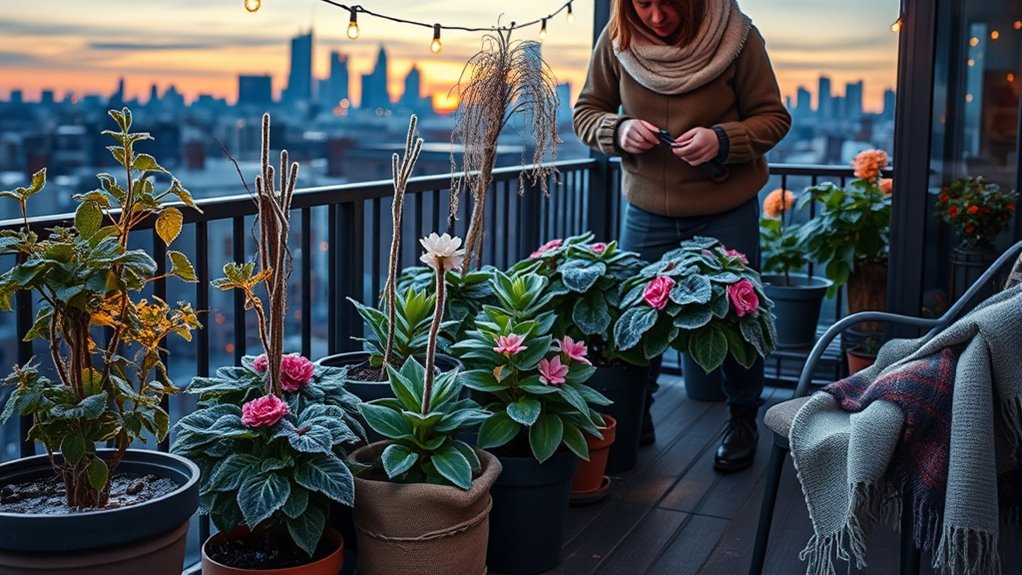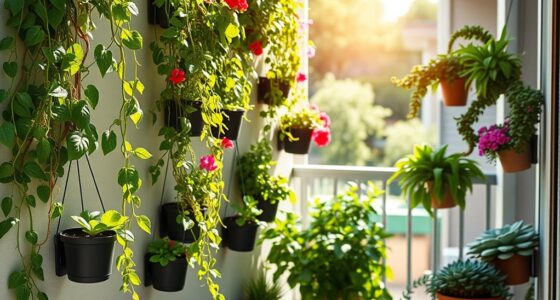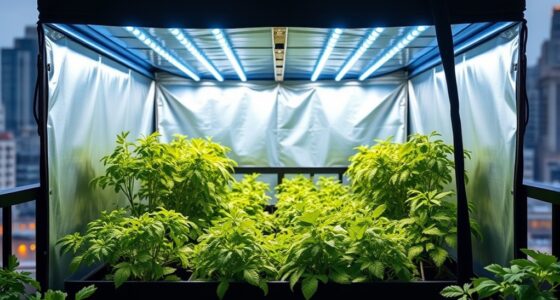To prepare your outdoor balcony plants for winter, assess their frost tolerance and choose hardy varieties suited to your climate. Use insulated containers made of durable materials and group them together in sheltered spots. Cover plants with burlap, straw, or frost cloth, and support these coverings to prevent wind damage. Water sparingly during dormancy and gradually reintroduce your plants outdoors in spring. For detailed tips on keeping your balcony plants healthy through winter, continue exploring expert strategies.
Key Takeaways
- Group potted plants together in sheltered spots and elevate containers to enhance insulation and drainage.
- Use frost cloths, burlap, or blankets supported by hoops to protect plants from cold and wind.
- Select containers made of non-porous materials like plastic or fiberglass, and ensure proper drainage.
- Water plants sparingly during cold spells, only when the soil is dry, to prevent root rot.
- Gradually move plants to sheltered microclimates and delay removing winter coverings until after the last frost.
Assessing the Frost Tolerance of Your Balcony Plants
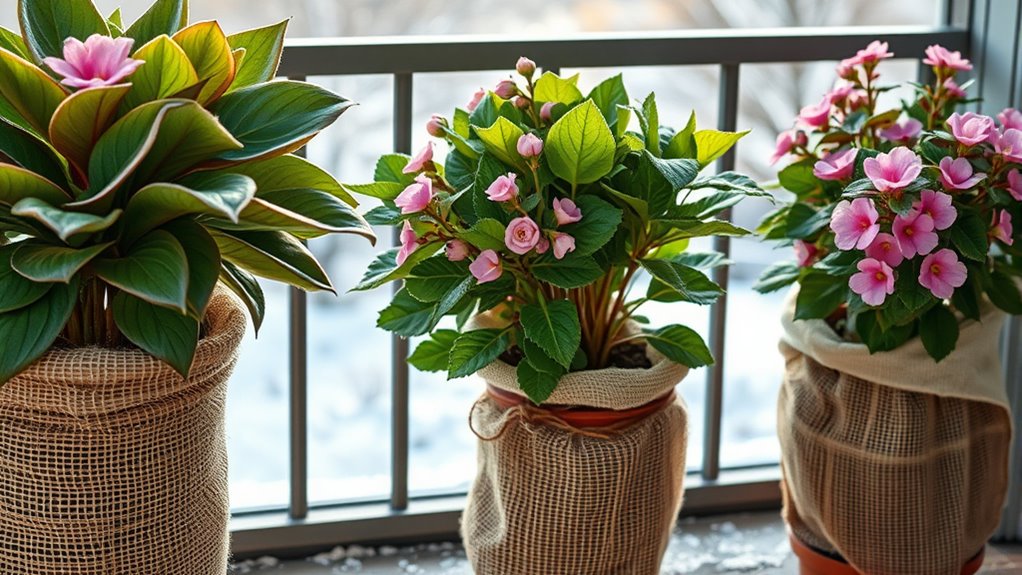
To effectively prepare your balcony plants for winter, you need to assess their frost tolerance. Understanding the frost tolerance of your outdoor plants helps determine which species can survive the cold or need extra protection.
Start by identifying your USDA hardiness zone and choosing plants at least two zones hardier to improve winter survival. Check each plant’s specific frost tolerance—whether it can withstand temperatures below 32°F or requires shielding. Look at labels or trusted gardening resources for the minimum outdoor temperature each species can tolerate. Incorporating innovative planter designs can also help create microclimates that offer additional warmth and protection for vulnerable plants. Emphasizing creative practice in your gardening routine can enhance your ability to adapt and innovate with different protective strategies.
Keep in mind that woody perennials and shrubs generally endure colder temperatures better than tender tropical plants or herbaceous annuals. Assess your local winter climate, including lows and freeze frequency, to match your plants’ frost tolerance for ideal winter survival. Additionally, understanding plant resilience can help you select the most suitable species for your outdoor space during colder months. Employing protective coverings such as frost blankets or mulching can further enhance your plants’ chances of surviving harsh winter conditions and help optimize plant health during winter.
Selecting the Best Containers and Materials for Winter
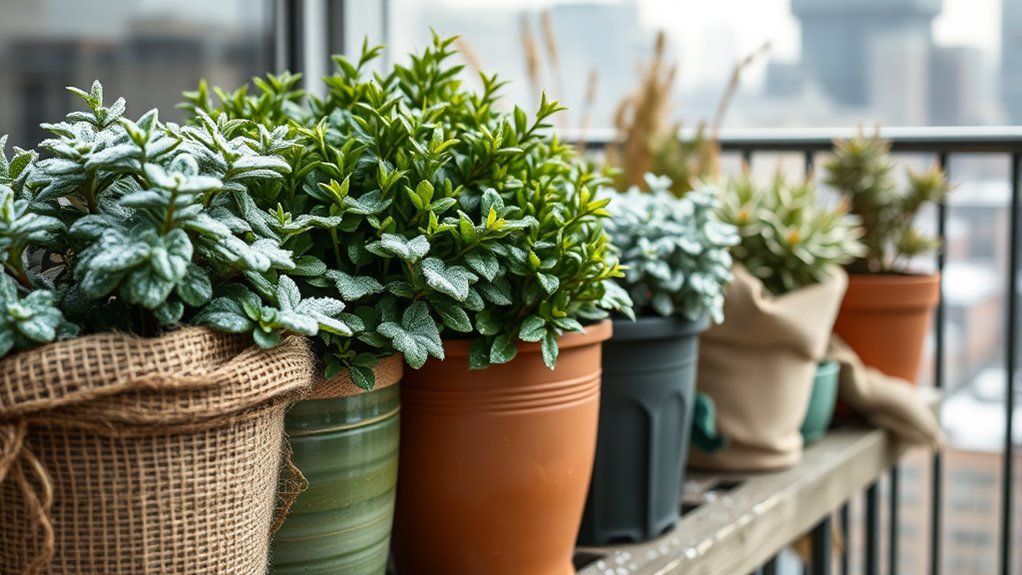
Choosing the right containers for your balcony plants in winter is crucial to protect their roots from freezing damage. Opt for containers made of plastic, fiberglass, or stonecast, which are at least ½-2 inches thick, as they withstand freezing temperatures better than terra cotta or ceramic.
Avoid porous materials like terra cotta, concrete, and glazed ceramic pots, since they crack easily in cold weather. Larger pots, measuring at least 18-24 inches in diameter, help insulate roots and maintain plant health. Additionally, insulation techniques can further safeguard your plants during the coldest months. Using proper insulation methods can significantly improve winter survival rates for your balcony garden. Incorporating thermal protection strategies can help mitigate temperature fluctuations and extend the growing season.
Make certain your containers have drainage holes and fill them about two-thirds with potting soil before planting. Proper drainage prevents water from pooling, reducing the risk of root rot during winter.
Group pots together and place them on sheltered or elevated surfaces to improve insulation and protection. Wall organization systems can also help create a microclimate that shields plants from harsh winter winds and cold temperatures. Implementing insulating materials around the pots can provide extra thermal protection during extreme cold spells.
Implementing Protective Coverings and Insulation Techniques
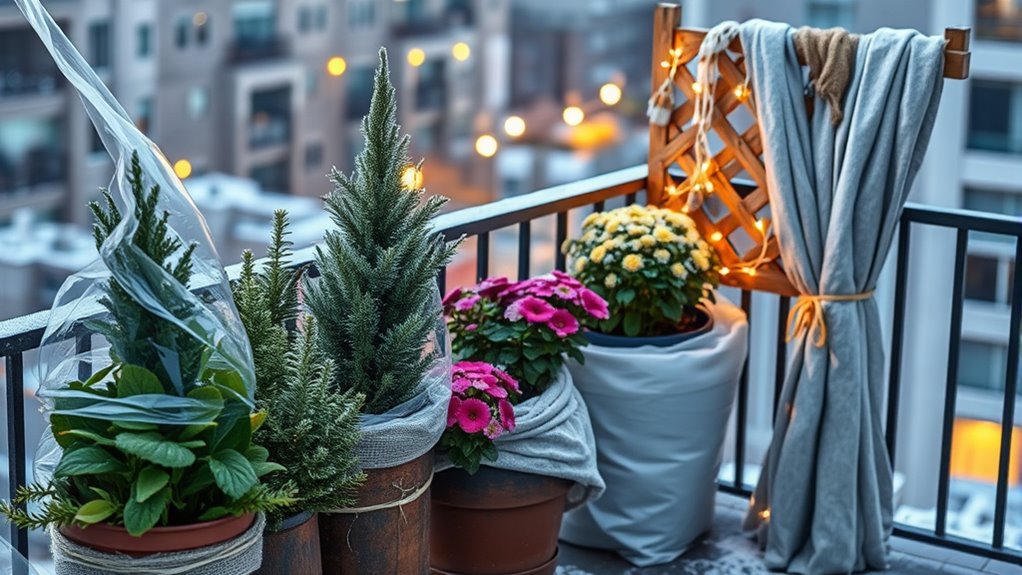
To safeguard your balcony plants, choosing the right coverings and insulation methods is key. You can wrap plants with materials like burlap, straw, or old sheets. Adding support with hoops or cages can help shield them from wind and cold. Implementing these techniques helps ensure your plants survive harsh winter conditions effectively. Using self-watering planter pots can also help maintain consistent moisture levels, reducing the stress on your plants during cold weather. Additionally, considering frost protection principles, creating a cozy and well-organized space for your gardening efforts can promote better care and attention to your plants during the winter months. Being aware of security vulnerabilities in your protective methods can help you choose more reliable materials and techniques.
Covering Materials Selection
Selecting the right covering materials is essential for effectively insulating outdoor balcony plants. Your choice of cover materials impacts insulation and helps protect outdoor plants from freezing temperatures.
Use evergreen boughs, straw, or burlap, secured with twine or wire, to wrap and insulate plants. For taller or columnar plants, enclose them with chicken wire filled with dried leaves, then add a waterproof tarp for extra protection.
During frost events, heavy plastic sheeting or multiple layers of newsprint can prevent freezing damage. Support taller plants with hoops and mesh netting to shield them from wind and snow weight.
Wrapping individual plants with frost cloths or old blankets, firmly anchored, further enhances protection. Proper material selection ensures your plants stay safe through winter’s chill.
Insulation and Support Methods
Implementing effective insulation and support methods is crucial for protecting outdoor balcony plants during winter. Wrap plants with evergreen boughs, straw, or burlap secured with twine or wire to insulate them against cold temperatures. Utilizing proper insulation techniques significantly reduces the risk of frost damage and helps maintain plant health during the colder months. Additionally, choosing cold-hardy plant varieties can enhance your garden’s resilience to winter weather. Enclose your plants with burlap or create chicken wire enclosures filled with dried leaves, then cover with waterproof tarps for added protection. Using seasonal coverings effectively shields plants from wind and frost while allowing air circulation to prevent mold and rot. During freezing conditions, place heavy plastic or layers of newsprint over plants to prevent frost damage. Incorporating winter-proofing methods can further strengthen your plants’ defenses against harsh conditions. Use supporting hoops and mesh netting around taller, columnar plants to provide stability and prevent breakage from snow or ice buildup. Elevate containers on supports like bricks or feet to improve drainage and reduce root freeze risks. These insulation and support methods help ensure your balcony plants survive harsh winter conditions.
Proper Watering and Fertilizing During Dormancy
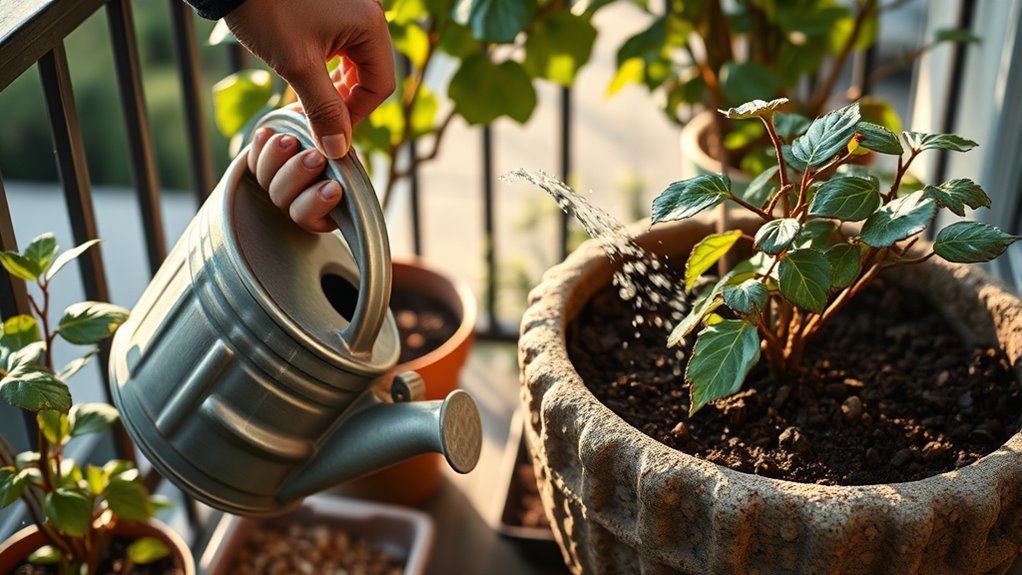
During dormancy, proper watering is essential to keep outdoor balcony plants healthy without risking overwatering. Only water when the soil feels dry, and avoid excess moisture to prevent root rot. Fertilizing outdoor plants isn’t necessary during winter, as lower temperatures and reduced sunlight limit nutrient uptake. For indoor shelter plants, use a diluted, water-soluble fertilizer lightly throughout winter to support their health. Remember to water before a heavy freeze to ensure hydration, but stop watering during prolonged cold spells to reduce ice damage. watering frequency should be adjusted based on indoor temperature and humidity levels to maintain optimal plant health. Proper water management during dormancy helps prevent issues like overwatering and ensures that your plants stay healthy and resilient through the winter months. Additionally, understanding plants’ water needs during dormancy can help prevent problems such as dehydration or fungal diseases. Being aware of plant-specific requirements can further optimize your winter plant care routine, especially considering the water requirements for extra-large houseplants that may vary depending on size and environment.
Moving and Arranging Plants for Optimal Winter Survival

Start by moving your plants to sheltered areas like east or north exposures to shield them from harsh winds and temperature swings. Group potted plants together and elevate containers on bricks or stands to improve drainage and prevent root freezing. Protect taller or fragile plants with covers or enclosures to keep them safe during severe cold snaps. Consider using air quality monitoring to assess indoor conditions and ensure your plants are not affected by pollutants or stagnant air. Additionally, consider using free crypto opportunities to fund additional outdoor plant supplies or winter protection tools.
Select Sheltered Locations
Choosing sheltered locations for your balcony plants is essential to protect them from harsh winter conditions. Place your container plants against walls, under eaves, or in corners to shield them from freezing temperatures and drafts.
Elevate pots on bricks, feet, or stands to improve drainage and reduce frost damage from prolonged ground contact.
Group plants on east or north-facing exposures to minimize harsh winter sun and wind, helping them build cold tolerance.
Use sturdy supports or hoops for taller plants to prevent damage from strong winds and heavy snow.
For especially vulnerable or less hardy plants, consider placing them in protected areas like garages, sheds, or under overhangs for extra insulation during severe cold spells.
Proper placement is key to protecting your plants and ensuring their winter survival.
Group Plants Together
Grouping your balcony plants together in sheltered spots, like along building walls or on east- or north-facing exposures, creates natural windbreaks and helps retain warmth. When you group plants, you improve insulation and reduce cold drafts, increasing their chances of overwintering successfully.
To optimize protection, consider these steps:
- Arrange plants close together to form microclimates, with hardy plants in the center and tender ones on the edges for added shelter.
- Consolidate containers into larger clusters to enhance insulation and minimize heat loss from individual pots.
- Elevate grouped plants on risers or supports to boost drainage and prevent cold soil from contacting the ground directly.
This strategy helps create a warmer, more protected environment for your plants during winter.
Elevate Containers for Drainage
Elevating your balcony containers is a simple yet effective way to improve drainage and protect roots during winter. By elevating containers on feet or bricks, you prevent water accumulation that can freeze and damage plant roots.
Raising the pots also reduces direct contact with the cold ground, helping insulate the roots and lessen freeze-thaw stress. Properly placed supports keep pots from sinking into wet or muddy soil during winter rains or snowmelt.
Using elevated platforms promotes better air circulation around the base of the containers, reducing moisture buildup and the risk of rot. Additionally, keeping containers off the ground helps prevent frost heaving, which can displace or crack pots and disturb plant roots.
Elevate containers now to give your plants the best chance for winter survival.
Preparing Plants for Transition Back Outdoors in Spring
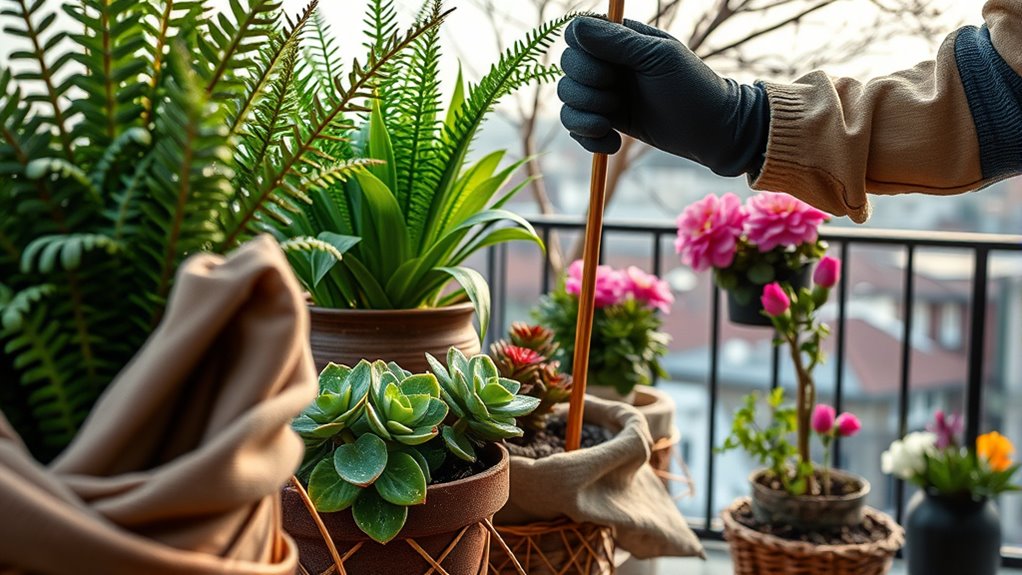
As spring approaches and the risk of frost diminishes, it’s time to gradually shift your indoor or protected outdoor plants back outside. To prevent cold weather shock, follow these steps:
- Over 7-10 days, increase their outdoor time gradually, covering the plant during colder periods to protect from sudden temperature drops.
- Wait until after the last expected frost date before removing winter coverings and permanently relocating the plants outdoors.
- Slowly reduce watering and fertilization to help plants adjust, monitoring for stress or pests as they adapt to outdoor sunlight and temperatures.
Reintroduce your plants to their usual outdoor positions once they show signs of healthy growth, ensuring they’re in suitable light and shielded from unexpected cold snaps.
Frequently Asked Questions
How Do I Prepare My Balcony for Winter?
To prepare your balcony for winter, you should move hardy plants two zones above your climate zone to protect them.
Use durable containers like plastic or stonecast instead of clay, and group your pots in sheltered, north or east-facing spots.
Cover plants with burlap or straw, and water thoroughly before the first freeze, keeping the soil slightly moist.
These steps help your plants survive harsh winter conditions.
Should I Bring My Outdoor Potted Plants Inside for the Winter?
Imagine your vibrant plants, shivering as the cold winds bite. You should bring your outdoor potted plants inside for winter if they aren’t hardy to your climate.
Moving them indoors shields roots from freezing and cracking. Make certain they get enough light, humidity, and cooler temps.
Gradually acclimate them to indoor conditions to prevent shock. Smaller pots are easier to move, but larger ones may need extra care or shelter.
Are You Supposed to Cut Back Plants for Winter?
You might wonder if you’re supposed to cut back plants for winter. It depends on the plant type.
Many perennials and shrubs benefit from pruning in late autumn to promote healthy growth and prevent disease. However, some plants, like ornamental grasses, are best left uncut until spring for winter interest and protection.
Always research your specific plants, and avoid trimming too late, which can expose them to cold damage.
What Do You Spray on Plants Before Bringing Them Inside for Winter?
You should spray your plants with a fungicidal solution like neem oil or a copper-based fungicide before bringing them inside. This helps prevent fungal diseases during winter dormancy.
Additionally, use horticultural insecticidal soap or neem oil to eliminate pests and eggs. Make sure the spray dries completely before indoor transfer to avoid mold or mildew.
Always follow the manufacturer’s instructions for safe and effective application.
Conclusion
Don’t worry if some plants seem fragile—they can often survive winter with the right care. By evaluating their frost tolerance, choosing suitable containers, and adding protective coverings, you can keep your balcony garden thriving year-round. Even if you’re concerned about extra effort, these simple steps protect your plants and save you time and money in the long run. With a little preparation, you’ll enjoy a lush, healthy balcony garden come spring.
